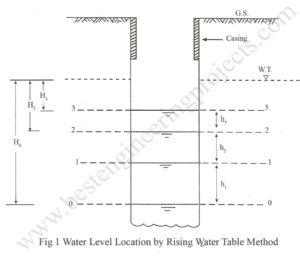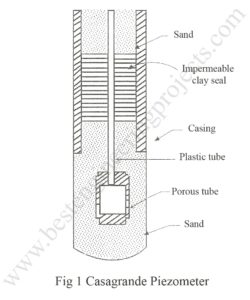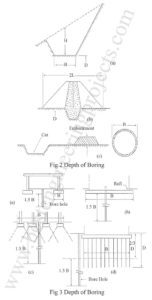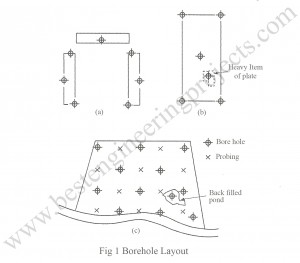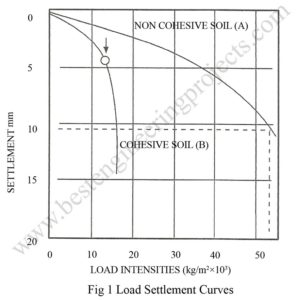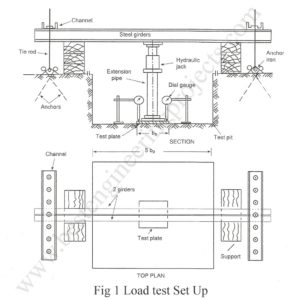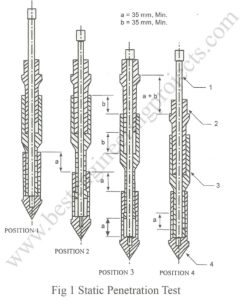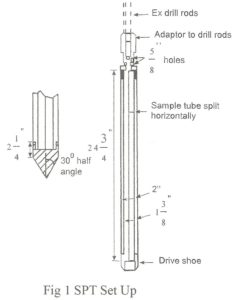Introduction to Hvorslev Method for Water Table Location As per the Hvorslev Method for Water Table Location, water table level can also be located in a borehole used for soil investigation. That type of bore hole should have a casing to stabilize the sides. It uses almost the same technique, the rise in water level determines the water level locations. However, there is a slight difference. Unlike Casagrande piezometer method, this method consists of hailing the water out of the casing and observing the rate of rise of the water level…
Read MoreCategory: Site Investigation
Casagrande Method for Ground Water Observation
Here in this article we will discuss about Casagrande Method for Ground Water Observation. From the foundation design and construction point of view, it is fundamental to have reliable information about the ground water level which lies within the zone of influence of a foundation to be settled. For this, the simplest way to gain information is to observe the nearby ground water table in open wells when they are available. We can find out the ground water table from boreholes. As we advance the borehole through drilling process, after…
Read MoreDepth of Boring | Bore Logs
Introduction to Depth of Boring: In this article we will discuss about Depth of boring and depth of boring bore log. The depth of soil affected by the load transmitted by the foundation determines the required depth of boring in the overall process. The additional stresses imposed by the foundation to a depth of one and half times the total width of foundation is still found to be about 20% below the foundation base. At the depth equal to two times the width of foundation, this stress is about 10%.…
Read MoreBore Hole | Table for Minimum Spacing of Bore Hole
What is bore hole and What are the table for minimum spacing of bore hole? During advancing the bore hole, it must be made as close as possible to the proposed location of the foundation. This is particularly important where soil strata are erratic or irregular. Figure 1 shows typical layouts for multistory building, factory building and the site where the layout of the structure has not been decided. Whereas tabl2 show table for minimum spacing of bore hole. For extensive areas, it is possible to adopt a widely spaced…
Read MoreLoad Settlement Curve
What is Load Settlement Curve? After obtaining the test results, a load settlement curve as shown in Fig.1 is plotted. In the figure, two curves A and B are shown. These two curves represent two different type of soils. The curve A is a typical curve for a sandy soil; non cohesive type, while the curve B is for clayey soil; cohesive type. For sandy soil, the nature of curve is straight in early part and with gradual increase in load intensities, it becomes steeper in later part and the…
Read MorePlate Load Test | Plate Load Test Procedure and Limitation
What is plate load test? in this article we will discuss about Plate Load Test Procedure and Limitation. The general set up for the plate load test is shown in Fig.1 below. Plate load test enables to estimate the allowable pressure of soil. The plates used in this particular phenomenon are usually square or round and these plates vary in sizes from 30 to 60 cm width and thickness about 2.5 cm. In comparison to other tests, Plate load tests are found to be quite expensive. Plate load test is…
Read MoreStatic cone penetration test
What is Static Cone Penetration Test or Cone Penetration Test? The static cone penetration test is also known as cone penetration test (CPT) since the cone is used to penetrate through the ground surface. The penetro-meter used in this process consists of a 600 cone with a base area of 10 cm2 and a friction jacket to avoid skin friction. Along with the diagrams in fig.1, the sequence of operation of the penetro-meter is briefly described below:- You can also check another for Dynamic Cone Penetration Test Operation procedure of Static…
Read MoreDynamic cone penetration test
Introduction The standard penetration test and dynamic cone penetration test are almost similar except for the fact that no bore hole is advanced in this test. As per the name of the test: Dynamic cone penetration, a Cone is fixed at the end of a drill rod which penetrates the ground as it is driven into the ground surface. Two types of DCPT are common in practices which are: dry DCPT and Wet DCPT. Previously, we had posted Static cone penetration test or cone penetration test. Dry Dynamic Cone Penetration Test…
Read More(SPT) Value Correction | Gibbs and Holtz | Bazara
SPT Value Correction – The observed SPT values as measured in the field are not reliable due to multiple factors and therefore need to be corrected. Two types of corrections which are usually applied for this task are: dilatancy and overburden pressure corrections. Dilatancy correction – The dilatancy correction can only be applied when the test is conducted in fine or silty saturated sand when recorded blow count is greater than 15. The correction factor as suggested by Terzaghi and Peck (1967) is as follows. Where, No = Observed N-Value…
Read MoreStandard Penetration Test (SPT)
During the course of site investigation, different penetration tests are carried out and these tests are enlisted below: Standard Penetration Test (SPT), Dynamic Cone Penetration Test (DCPT) and Static Cone penetration Test (CPT). Among these, Standard penetration test SPT is the most popular one and is widely used. Standard penetration test: The test is conducted by driving a split spoon (Fig 1 c) into the soil for a distance of 450 mm. The force required to drive the spoon up to that depth is provided by a standard hammer of…
Read More